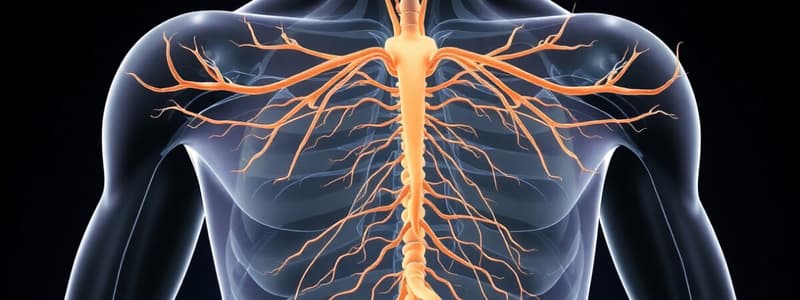Podcast
Questions and Answers
What is the primary function of the endocrine system?
What is the primary function of the endocrine system?
- To transmit electrical signals throughout the body
- To produce and secrete hormones (correct)
- To act as a communication system for reflex actions
- To provide structural support to body tissues
Which part of the neuron is responsible for receiving information?
Which part of the neuron is responsible for receiving information?
- Cell Body
- Myelin Sheath
- Axon
- Dendrite (correct)
What type of neuron processes information in the brain and spinal cord?
What type of neuron processes information in the brain and spinal cord?
- Interneuron (correct)
- Peripheral Neuron
- Motor Neuron
- Sensory Neuron
How do the effects of neurotransmitters differ from hormones?
How do the effects of neurotransmitters differ from hormones?
What does homeostasis refer to in living organisms?
What does homeostasis refer to in living organisms?
In a feedback mechanism, what does positive feedback do?
In a feedback mechanism, what does positive feedback do?
The nervous system directly controls which of the following?
The nervous system directly controls which of the following?
Which type of neuron initiates muscle contraction?
Which type of neuron initiates muscle contraction?
What is the primary function of a positive feedback mechanism?
What is the primary function of a positive feedback mechanism?
Which of the following describes the negative feedback mechanism for blood sugar regulation?
Which of the following describes the negative feedback mechanism for blood sugar regulation?
During thermoregulation, what physiological response occurs when the body gets too warm?
During thermoregulation, what physiological response occurs when the body gets too warm?
What role does oxytocin play during childbirth?
What role does oxytocin play during childbirth?
What triggers the release of oxytocin during lactation?
What triggers the release of oxytocin during lactation?
Which statement best describes the output of a feedback loop?
Which statement best describes the output of a feedback loop?
What is one of the results of a negative feedback mechanism?
What is one of the results of a negative feedback mechanism?
How does the body maintain homeostasis related to blood calcium levels?
How does the body maintain homeostasis related to blood calcium levels?
Study Notes
Endocrine System
- Comprises a series of glands that produce and secrete hormones.
- Hormones are vital for regulating various bodily functions.
Nervous System
- Functions as the body's communication network, connecting all parts.
- Transmits signals, processes information, and interacts with the environment.
- Key components include the brain, nerves, and spinal cord.
Neurons
- Neurons are specialized nerve cells essential for signal transmission.
- Dendrite: Receives information and transmits it to the cell body.
- Cell Body: Houses the nucleus and organelles.
- Axon: Conducts information away from the cell body.
Types of Neurons
- Sensory Neurons: Receive and process sensory information.
- Interneurons: Process information predominantly in the brain and spinal cord.
- Motor Neurons: Initiate action in muscles or glands to produce movement.
Homeostasis
- Refers to a stable internal environment maintained by living organisms.
- Achieved when body systems function in equilibrium.
Feedback Mechanisms
- Regulate internal changes through detection and response.
- Negative Feedback: Counteracts changes, maintaining stability.
- Common in processes like thermoregulation and blood sugar regulation.
- Example: Body cools by dilating blood vessels and producing sweat.
- Positive Feedback: Amplifies changes, promoting continuation of a process.
- Notable in processes like childbirth and lactation.
- Example: Oxytocin release during childbirth intensifies contractions.
Homeostasis Examples
- Thermoregulation: Body cools itself through sweating and blood vessel dilation.
- Osmoregulation: Balances water levels within the body.
- Regulating Blood Sugar:
- High blood sugar prompts insulin release to lower levels.
- Insulin facilitates cellular glucose absorption and storage.
Positive Feedback Instances
- Childbirth: Uterine contractions are stimulated by the release of oxytocin.
- Lactation: Suckling triggers the hypothalamus to release oxytocin, promoting milk secretion.
Importance of Hormones
- Hormones must be maintained at appropriate levels to achieve homeostasis.
- Key areas affected include body temperature, water levels, and metabolic waste concentration.
- Blood calcium levels and hormonal balance are critical for overall health.
Studying That Suits You
Use AI to generate personalized quizzes and flashcards to suit your learning preferences.
Description
Test your understanding of how the nervous and endocrine systems work together to maintain homeostasis in the body. This quiz will cover key concepts related to the functions, structures, and interactions of these two vital systems.




